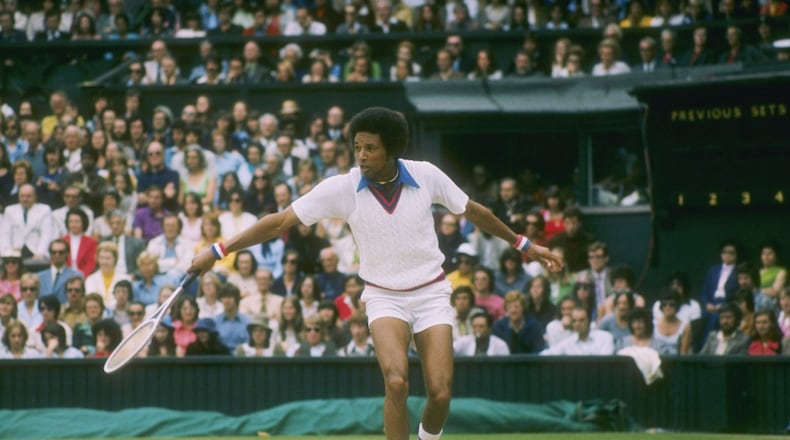Twenty five years have passed since tennis legend Arthur Ashe stood dignified and devastated, dressed in a gray suit and burgundy tie, hand to forehead and in the most poignant moments, handkerchief to his eyes, and admitted to the world that he had AIDS.
He leaned into an overloaded bank of microphones and in his soft-spoken, understated way, said, “Beginning with my admittance to New York Hospital for brain surgery in September 1988, some of you heard that I had tested positive for HIV, the virus that causes AIDS. That is indeed the case.”
Ashe’s announcement came five months after Magic Johnson rocked the sports landscape by revealing he was HIV positive and walking away from the Los Angeles Lakers. But Ashe’s confession, that he likely contracted AIDS from a blood transfusion, was all the more shocking.
In April 1992, AIDS was still widely considered the “gay curse” or the consequence of promiscuous sex or intravenous drug use. But here was a buttoned-down, well-educated, heterosexual man, married to a beautiful woman, with a 5-year-old daughter, standing there revealing his own death sentence. Ashe made it feel like it could happen to anybody.
The drug cocktail that treats the effects of AIDS was still four years away from being discovered. Just mention of the HIV virus evoked a unique kind of fear and paranoia. People infected with HIV were ostracized. AIDS was a modern-day leprosy.
Ashe broke with emotion when he got to the part of his three-page prepared statement about how his diagnosis affected his daughter, Camera. After minutes without a word, Ashe’s wife Jeanne had to finish his thought, saying, “Arthur and I must teach her how to react to new, different and sometimes cruel comments that have very little to do with her reality.”
Ashe came forward that day in New York City because he felt he had no choice. He’d been carrying the secret for nearly four years, since he underwent brain surgery for numbness in his arm and discovered he had an infection commonly associated with AIDS.
The night before the news conference, he got a call from a USA Today reporter who had been tipped off to Ashe’s condition. Ashe was worried the newspaper would expose it before he could announce it.
“I am angry that I was put in a position of having to lie if I wanted to protect my privacy,” he told reporters.
How many people, in that same scenario, would have lied?
“I did not want to have to go public now because I’m not sick,” Ashe said. “I can function very well and I plan to continue being active in those things I’ve been doing all along — if the public will let me.”
Ashe, the first African-American man to win U.S. Open and Wimbledon titles, was a pioneer in race relations. He had other causes he wanted to champion, but ultimately he turned to meet the challenge AIDS presented by creating the Arthur Ashe Foundation for the Defeat of AIDS within a month of his announcement.
“Ashe is a man of surpassing but understated eloquence,” Sally Jenkins wrote in Sports Illustrated. “… Because of the social circles he moves in, Ashe has a rare chance to demystify AIDS in places like country clubs, boardrooms, private schools and the White House.”
When Ashe explained you could not catch AIDS from a kiss, a sneeze or a handshake, people listened. He helped make it OK to talk about safe sex and condoms. He put a quiet dignity on the face of an ugly epidemic.
Ashe was scheduled to participate in an AIDS forum in Connecticut when he contracted AIDS-related pneumonia. He sent a video message to be shared at the forum before dying two days later on Feb. 6, 1993. He was 49.
“There can be no greater gift than that of holding out hope for those who have felt hopeless,” wrote Ira Berkow in the New York Times after Ashe’s passing. “Arthur Ashe possessed that rare gift, the ability to inspire.”
ESPN has named its annual courage award after Ashe. His name adorns tennis stadiums around the country, most notably at the U.S. Open in Flushing N.Y.
The nation’s donated blood supply has been tested for HIV since 1985. HIV diagnoses in the United States had decreased by nearly 20 percent over 10 years before 2015, according to the Centers for Disease Control and Prevention.
About the Author
Keep Reading
The Latest
Featured


